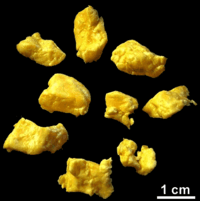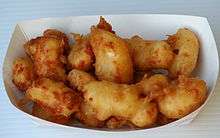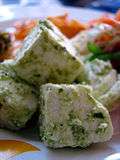Cheese curd

Cheese curds, in cuisine or cooking, are the solid parts of curdled milk either eaten alone or used in various regional dishes mostly in Canada and the northeastern and midwestern United States. They are sometimes referred to as "squeaky cheese".[1][2]
Production
Cheese curds start off with fresh milk. The milk is pasteurized, much like in the process of creating cheese. During this process, rennet is added to clot the milk. After the milk has been pasteurized, the result is a mixture of whey and the early stages of the curd. This mixture is then cooked. Next, it is pressed to release the whey from the curd, thus creating the final product of cheese curd.
Characteristics
Their flavor is mild, but can differ in taste depending on the process in which it was made. It has about the same firmness and density as cheese, but with a springy or rubbery texture. Fresh curds squeak against the teeth when bitten into, a defining characteristic due to air trapped inside the porous material. This "squeak" has been described by the New York Times as sounding like "balloons trying to neck".[3] After 12 hours, even under refrigeration, cheese curds lose much of their "fresh" characteristic, particularly the "squeak".[4] Keeping them at room temperature can preserve the squeakiness.
The curds have a mild flavor and are sometimes somewhat salty. Most varieties, as in Ontario, Quebec, Nova Scotia, Vermont, or New York State, are naturally uncolored. The American variety is usually yellow or orange, like most American Cheddar cheese, but it does not require the artificial coloring.
Uses

Fresh
Fresh cheese curds are often eaten as a snack, finger food or an appetizer. They may be served alone, dressed with an additional flavor, or with another food, such as a small smoked sausage or piece of cured pork, with the elements skewered together on a toothpick. Examples of flavorings applied to fresh curds include jalapeño chili peppers, garlic, various herbs, or spice blends such as Cajun seasoning, with garlic and dill on cheddar curds being a popular combination.[5]
Fried cheese curds
In the Midwestern United States (particularly in Wisconsin and eastern Minnesota) fried cheese curds are a local delicacy. Deep-fried cheese curds are often found at carnivals and fairs, and often local non-chain fast-food restaurants and at regular restaurants and bars, as well as a few chain restaurants of local origin including Cousins Subs and Culver's. They are also available at A&W and some Dairy Queen locations. Deep-fried cheese curds are covered with a batter, similar to one used for onion rings, or are breaded and placed in a deep fryer, they are sometimes served with a side of ketchup, marinara sauce, or ranch dressing.[6]
In many areas where fried cheese curds are common, the term "cheese curds" refers to the fried variety; non-fried curds are distinguished by calling them "raw" or "plain" cheese curds.
In some areas, deep-fried cheese curds are also known as cheeseballs.[7]
Poutine

Cheese curds are a main ingredient in poutine, a dish consisting of french fries topped with fresh cheese curds, covered with brown gravy and sometimes additional ingredients. The dish originated in rural Quebec, Canada, in the late 1950s. Several Québécois communities claim to be the birthplace of poutine.
Paneer

In the Indian subcontinent, fresh cheese curd is also known as cottage cheese. It is made by boiling milk and then adding an acid (vinegar, lemon juice) to curdle it. Once the milk is curdled, the watery portion is discarded and the white casein is retained. It is then put into a mold and made into a roughly rectangular or oval shape. Paneer, as it is known all over the country, is widely used in snacks, appetizers, main course, and rice biryani. It is an alternative to meat and is very popular especially in India.[8]
See also
- Fried cheese
- Leipäjuusto (Finnish squeaky cheese)
- Halloumi
- Cottage Cheese
References
- ↑ Heidi Knapp Rinella (2006-11-15). "Taste of the Town: Squeaky cheese curds spotted in valley". Las Vegas Review-Journal. Retrieved 2009-06-22.
- ↑ Ryan List (2002-10-21). "Cheese squeaks in your mouth". Ludington Daily News. Retrieved 2009-06-22.
- ↑ Louisa Kamps, "Cheese Curds," NY Times, October 17, 2004
- ↑ Tillamook Cheese Factory FAQs
- ↑ "Archived copy". Archived from the original on 2011-10-26. Retrieved 2011-09-12.
- ↑ Lewis, Chelsey (April 21, 2016). "Are Fried Cheese Curds Wisconsin's Most Important Food Innovation?", Milwaukee Journal Sentinel. Retrieved May 21, 2016.
- ↑ Belleville, Kansas Dairy Queen website Archived April 25, 2010, at the Wayback Machine.
- ↑ https://food-nutrition.knoji.com/how-to-make-paneer-indian-cheese/
External links
| Wikimedia Commons has media related to Cheese curds. |